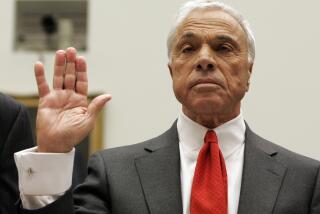Amwest Group Thrives Insuring That Others Perform as Promised
WOODLAND HILLS — Dick Savage was working in San Francisco looking for dope pushers. Savage, a narcotics cop for the state Justice Department, eventually realized his search would not end soon because drug abuse was on the rise.
“I just saw it as a social problem that wasn’t being solved,” he said. “I didn’t want to be a part of it anymore. At the grand old age of 38, I said, ‘This is for the birds,’ took my three kids and my wife and moved south” to San Diego.
That was 30 years ago. Savage turned in his badge, but he still knew something about the court system--including how bail is posted. Once he arrived in San Diego, he took his $25,000 savings and bought a bail-bond agency.
Today, Richard H. Savage is still in the bail-bond business, but in a much bigger way. He is chairman and chief executive of Amwest Insurance Group, a thriving specialist in an arcane type of insurance called surety bonds.
To define surety as insurance is almost a misnomer; it’s more like a credit guarantee. When Amwest underwrites a surety bond, it is guaranteeing that another business or individual--the policyholder--will uphold an agreement it has with a third party. If the policyholder does not uphold the agreement, Amwest has to step in and make good on the amount of the bond.
For most of Savage’s career, surety bonds were a steady if not spectacular business. But beginning in the early 1980s, Amwest has been on a hot growth streak that shows little sign of slowing.
This year Amwest’s revenue likely will be $20 million, a tenfold jump from 1980. Its profit climbed by the same degree, to $2.1 million last year from $258,000 in 1980. Eight years ago Amwest offices were in only California; today they are in 39 states.
Savage has already turned his original $25,000 investment into $9 million worth of Amwest stock, but he wants more. His goal is for Amwest to be in every state by 1989, with more than 100 branch offices, while reaching $100 million in annual insurance premiums within the next five years.
Such ambition has industry analysts urging Amwest to be cautious, lest it spread its resources too thinly.
“Although we view Amwest favorably and believe it’s a well-run company, expansion into new territories always brings additional risks,” said Vita Marino, vice president of research at Firemark Insurance Review, a research firm in Morristown, N.J.
It’s also expensive. In the nine months ended Sept. 30, Amwest’s total costs, which include payment of claims, jumped 52% from a year earlier to $14.3 million.
So far, the higher costs have not slowed Amwest’s earnings momentum. The company’s net income in the period climbed 40% from a year earlier, to $2.1 million, or $1.06 a share, while its return on equity was an impressive 22%.
Much of Amwest’s surety bond business comes from contractors who must be bonded to work for government agencies. The firms that paint the post office or build a playground for a school usually must be bonded because federal and state agencies don’t want to be bothered if the contractor can’t finish the job. It wants that problem fixed by the bond’s underwriter.
The contractor buys coverage from Amwest in whatever bond amount is required by the government agency. Savage said the typical premium at Amwest is about 2% to 3% of the bond amount, so a $5,000 bond would cost the contractor $100 to $150.
If the contractor goes broke before the job is done--a not uncommon event--Amwest either would have to give the contractor more money to finish the job, or hire another contractor. Of course, if the bonded contractor does the job as agreed, Amwest simply pockets the $100 to $150, less expenses.
Many retailers must also be bonded to assure they won’t keep sales taxes that they should be forwarding to the government, as are retailers that sell hunting and fishing licenses.
Even private enterprises often require surety bonds. The owner of an apartment building, for example, might want its manager bonded in case he skips town with the month’s rent checks.
Although many of the big insurance companies, such as Safeco, USF & G and Kemper, underwrite surety bonds, they focus on major construction projects or on underwriting only those policyholders with top-grade credit, Savage said. Amwest specializes in the little guy. The median-size contract it covers is about $100,000, and it seldom covers one costing more than $1.5 million.
“We’re mostly for the smaller contractors who really can’t get bonds from the larger companies, because the larger companies are looking for a minimum annual premium from these guys of anywhere from $15,000 to $25,000,” said Robert C. Goodell, Amwest’s chief financial officer. “A lot of the guys we bond might do only one bonded job a year,” each providing only a few hundred dollars in premiums, he said.
sh 25% in Claims
Despite Amwest’s willingness to take on smaller businesses, which might seem to come with higher credit risks, Amwest pays out only about 25 cents in claims for each dollar it collects in premiums. By comparison, the industry’s “loss ratio” is nearly 60 cents per dollar.
“There are other people who call us substandard, and that’s OK by us too. The money spends very nicely, thank you,” Savage said.
Good old-fashioned bail bonds account for 15% of Amwest’s business. If someone is arrested and his bail is set at $10,000, he could pay the full amount to be released until his next court appearance, or he could buy a bail bond from Amwest, which typically costs 10% of the bond’s value. Amwest guarantees that the person will appear in court, otherwise it forfeits the $10,000.
Savage credits Amwest’s recent growth and below-average claim losses to his diversification into several types of surety bonds, and his decision five years ago to start requiring collateral from many of its policyholders.
Just as auto insurers don’t require drivers to put up their cars as security, Savage explained, many surety companies don’t require the policyholder to post collateral. Now Amwest requires collateral from policyholders for the more expensive bonds it underwrites. The collateral could be a home mortgage, trust deed or cash, and might cover only a portion of the bond, but it helps offset Amwest’s losses if the policyholder defaults.
“If we didn’t have collateral, our loss ratio would be about three times what it is,” Goodell said.
Savage, who controls nearly half of the company’s 2 million common shares outstanding, along with his other shareholders, had benefited from Amwest’s growth until the stock market’s crash Oct. 19.
Amwest went public in November, 1985, at the equivalent of $8.10 a share (accounting for a 10% stock dividend in February), climbed to a high of $15.75 a share earlier this year, and was still trading at about $12 when the crash occurred. The stock was trading recently at $9.50 on the American Stock Exchange.
Before the market’s crash, Amwest had planned to raise $8 million through another stock offering; now the company will have to borrow the money.
sh Studied Police Administration
Savage was born and raised in Redwood City, in the San Francisco Bay area. He studied police administration for two years at San Jose State University, then was drafted into the Army in 1941 shortly before the start of World War II. He was a radar controller in the South Pacific, helping to locate enemy planes, and had reached the rank of captain when the war ended in 1945.
Savage then became a Palo Alto police officer for two years. He spent two years as a California Highway Patrol officer in Santa Clara County and then put in six years with the Justice Department’s narcotics force.
After opening his bail-bond agency in San Diego, Savage sold it just one year later. He moved to Los Angeles and formed another bail-bond firm that was the foundation for Amwest.
Now Savage is 68. “I’ve got good health. My blood pressure is 116 over 68. You keep those numbers for the rest of your life and you’ll be in good shape,” he said, with the expertise of an actuary.
He is an avid sailor and deep-sea fisherman, but does not plan to retire for at least four or five years. Savage has not designated a successor. Two of the company’s top-ranking executives are Gary R. Peterson, president, and Savage’s son, John E. Savage, 35, Amwest’s senior vice president.
Meanwhile, the elder Savage said he has been “practicing letting go” by delegating more authority. “Now, I’ve got a helluva team here,” he said. “I could blow it out tomorrow, and this company isn’t going to suffer.”
More to Read
Inside the business of entertainment
The Wide Shot brings you news, analysis and insights on everything from streaming wars to production — and what it all means for the future.
You may occasionally receive promotional content from the Los Angeles Times.











